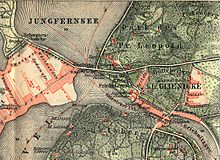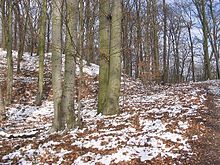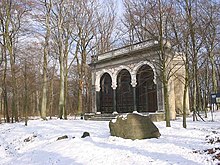Böttcherberg
The Böttcherberg in the Klein Glienicke landscape park is part of the world cultural heritage of Berlin - Potsdam's cultural landscape, which stretches from the Pfaueninsel to Werder and has been under UNESCO protection since 1990 with its palaces and gardens .
The 67 m above sea level. NN high elevation is located in the Berlin district of Wannsee in the Steglitz-Zehlendorf district immediately next to Königstrasse ( Bundesstrasse 1 ) between the Klein Glienicke Park and the Babelsberg Park in Potsdam . The former village and today's villa district of Klein Glienicke at the foot of the mountain, in contrast to the Volkspark of the same name, belongs to Potsdam, which extends like an enclave over the area of Berlin's Wannseeplatte. The mountain and villa district are separated from the Babelsberg Park by the Griebnitzsee , the Glienicker Lake and the connecting piece between the two lakes, the continuation of the Teltow Canal . The small “park bridge”, which can only be used alternately in one lane, connects both parts of the landscape.
Prince Carl of Prussia commissioned Peter Joseph Lenné to design the Glienicker Park. Lenné, who wanted to transform the Potsdam area into a total work of art, included the Böttcherberg in the garden design plans. Based on a design from 1832, Lenné first planned the construction of a cottage - a lookout point was realized with the visual axes typical of Lenné's works , which were directed towards the Jungfernsee , Weißen See , Krampnitzsee and Griebnitzsee. In the 1860s, the name Rondell or fan view became common for the lookout point .
Near the highest elevation is the loggia Alexandra , which opens in a semicircle to the park and which Prince Karl had built in 1869 to commemorate a deceased sister. The loggia, the gem of the Böttcherberg, was restored after the political change . The original Lenné design of the mountain area could also be largely restored from a garden conservation point of view towards the end of the 20th century.
From 1791 to 1804 the Böttcherberg was owned by Christian Böttcher, today's namesake. Until 1791 it was called Alter Weinberg due to the wine growing on its slopes and before that, when it was still used for agriculture, it was called Ackerberg . The hill has belonged to Berlin since 1928.
Geologic is the Böttcherberg part of Berlin-Brandenburger Teltow , a flat wave high surface with an up to 15 meters thick layer of gravel , marl and sand , the water masses of the defrosting glacial between the Endmoräne Flaming or the upstream Baruther glacial valley and the Berliner Urstromtal before about 15,000 years ago in the Brandenburg stage of the Vistula Ice Age .
Coordinates: 52 ° 25 ' N , 13 ° 6' E


